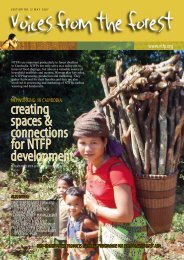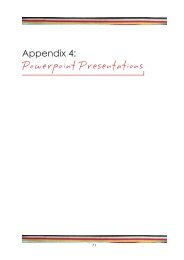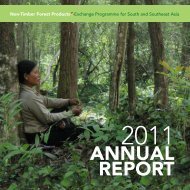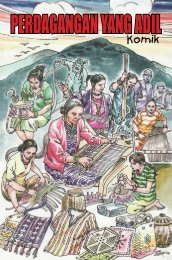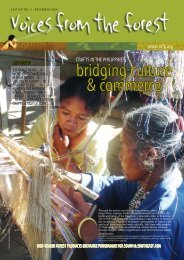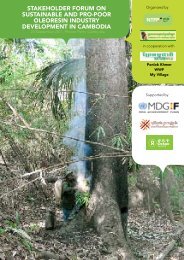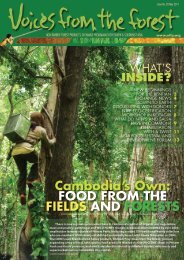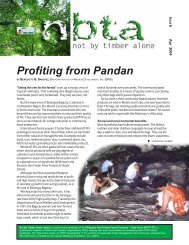November 20 - Non-Timber Forest Products Exchange Programme
November 20 - Non-Timber Forest Products Exchange Programme
November 20 - Non-Timber Forest Products Exchange Programme
You also want an ePaper? Increase the reach of your titles
YUMPU automatically turns print PDFs into web optimized ePapers that Google loves.
16<strong>Non</strong>-<strong>Timber</strong> <strong>Forest</strong> <strong>Products</strong> TaskForce (NTFP-TF) and partnershave been busy in recent years,testing a new, cost-effective toolfor sustainable NTFP managementin the Philippines.This tool is called ParticipatoryResource Monitoring or PRM.‘Resource Monitoring’ isthe systematic gathering ofinformation about managedresources in order to determinewhether there has been anychange over time. The informationmust be collected at regularintervals in a manner that is costefficient,not overly burdensomeand appropriate for supportingmanagement objectives. Thisinformation is then analyzed, andthe results are evaluated and usedfor decision-making about futuremanagement.‘Participatory ResourceMonitoring’ means that localcommunities who are involvedin managing these resourcesare fully involved in planning,implementing, evaluatingPARTICIPATORYRESOURCEMONITORINGWritten by: Mary Stockdale and Katherine Mana-Galidoand responding to resourcemonitoring.In the past decade, awarenessof the importance and role ofparticipatory resource monitoring(PRM) has grown significantly. Arecent review (Guariguata andEvans, <strong>20</strong>08) of participatorymonitoring in tropical forestmanagement, conducted for theCentre for International <strong>Forest</strong>ryResearch (CIFOR), has foundthat this type of monitoring isincreasingly assuming a centralrole in sustainable tropical forestmanagement, by encouraginglocal people to record informationabout their forest, reflect uponit, and take management actionin response to what they havelearned. The CIFOR review hasfound that monitoring is now beingused in dozens of tropical countries,and for a variety of objectives,including biodiversity conservationand wildlife management, humanwellbeing, political processes andinstitutions, ecosystem services,and non-timber forest product(NTFP) management.Some of the observed benefitsof PRM, when it is properlyconducted, include: integratinglocal knowledge into scientificmonitoring, empowering localpeople, strengthening localinstitutions, and facilitatingdecision-making. However thereare also some potential problems:PRM may not always be easy forcommunities to implement, itmay not always gather sufficientlyreliable information, and if toocostly or difficult, it may not proveto be sustainable once externalsupport is removed.The Department of theEnvironment and Natural Resources(DENR) of the Philippines has beena pioneer in exploring the potentialof participatory monitoring fornational programs. Park staff fromthe Protected Areas and WildlifeBureau (PAWB) have workedtogether with local communitiesfor a number of years to monitorthe biodiversity of 35 ProtectedAreas (PAs), 25 of which wereland-based and 10 of which weremarine. Much has been achieved,and much learned from thisinnovative program.Presently, the DENR’s <strong>Forest</strong>Management Bureau (FMB)is working together with theUniversity of Philippines - LosBanos <strong>Forest</strong>ry DevelopmentCenter (UPLB-FDC) and the NTFPTask Force (NTFP-TF) to examinewhether PRM can be used as atool for sustainable managementof NTFPs in forests that are undercommunity management tenures,such as Ancestral Domains (CADC,CADT) or Community-Based<strong>Forest</strong> Management Agreement(CBFMA) areas.This project has been initiated inresponse to concerns expressedby local communities and theirsupporters over the approachpresently required by the DENR:namely, the use of resourceinventory and the calculation ofa Sustained Yield Cut (SYC) asthe basis for management. Therehas been considerable pressurefor a practical, affordable, andcommunity-friendly alternative.Two possibilities are beingexamined in this project: theSimplified NTFP Inventory System(SNIS) and Participatory ResourceMonitoring (PRM).Starting in <strong>20</strong>09,these partners have worked with



